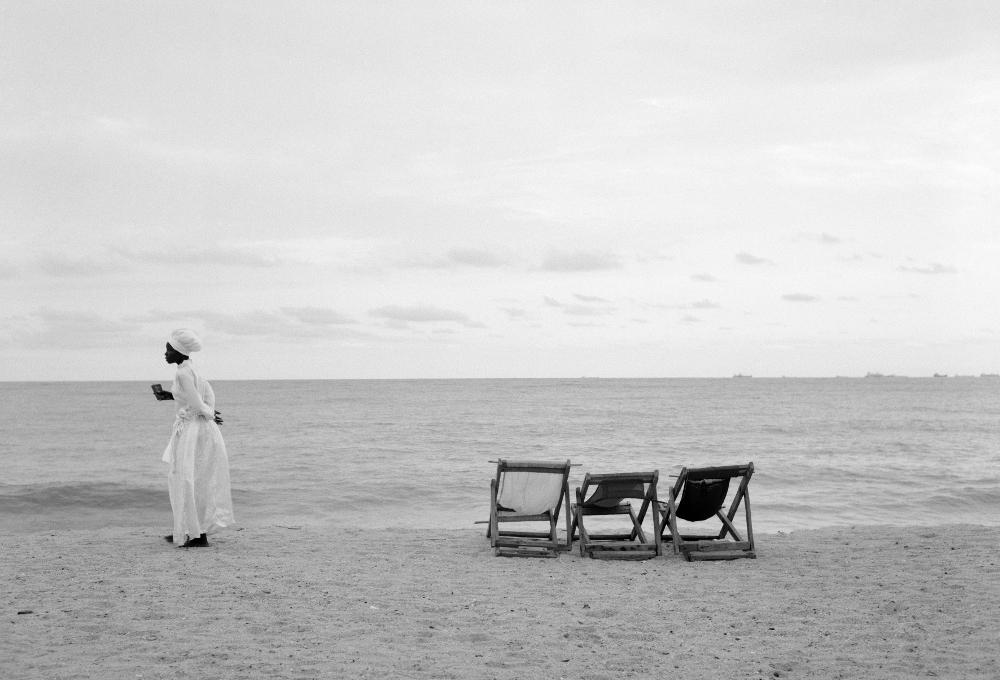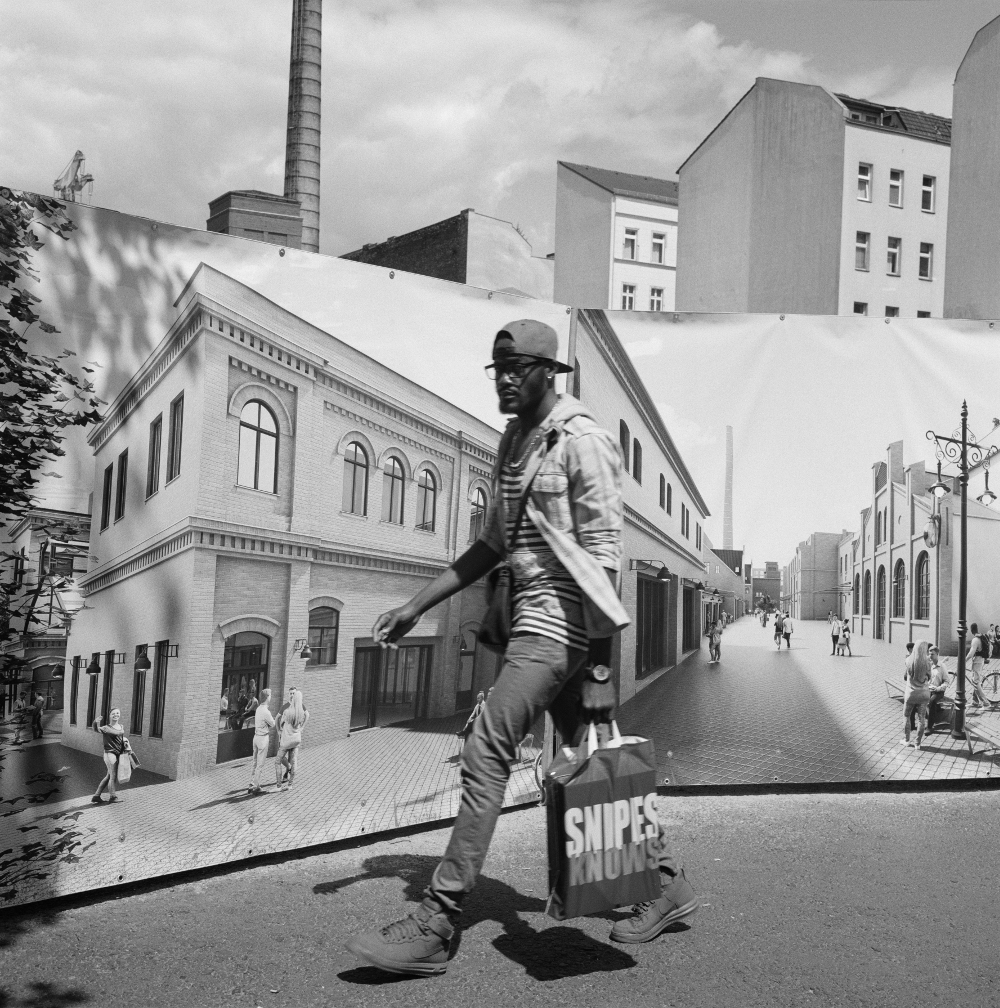 Photo courtesy of the artist. Akinbode Akinbiyi Lagos Island, Lagos, 1988. From the series Lagos: All Roads. Catch Six Songs, Swirling Gracefully in the Taut Air through May 17 at Martin Gropius Bau.
Photo courtesy of the artist. Akinbode Akinbiyi Lagos Island, Lagos, 1988. From the series Lagos: All Roads. Catch Six Songs, Swirling Gracefully in the Taut Air through May 17 at Martin Gropius Bau.
Born in Oxford, England, in 1946, Nigerian photographer Akinbode Akinbiyi has also lived in Lagos, London and Heidelberg before he settled in Berlin in the 1990s. He prefers to be called a photographer but produces both art and photojournalism (British newspaper The Observer were the first to publish his photos in 1977). Akinbiyi’s black and white photographs have taken the self-professed wanderer across the world and often chronicle communal and intimate life amidst the noisy streets of major cities. His work was included in the recent Documenta 14 in both Kasel and Athens, and he has shown at Berlin’s SAVVY Contemporary and in biennials in Frankfurt, Tokyo, Paris and Philadelphia among many others.
Subscribe to our weekly Newsletter

NEWSLETTER
Leave this field empty if you’re human:
Your show at Gropius Bau is called Six Songs, Swirling Gracefully in the Taut Air. What’s the story behind that?
I very much like the idea of listening. I think in listening we see more, that’s why I put in the idea of songs and I’ve been working with the different themes for many years, and then all the time I’m wandering around and listening. The “taut air”, that’s about a kind of tension in the air, not just here, everywhere.
In your show, there is work you shot in Wedding’s African Quarter, right?
Yes. That part of Wedding has an interesting history. In the late 19th century, a big zoo enterprise acquired some land outside the Berlin city limits and they wanted to build a zoo there and also a human zoo, something where they would show people from Africa in cages. But that plan never came to fruition. Then the city, expanding due to industrialisation, bought up this land and started giving African names to the streets there. I’m not sure if it was because of the zoo, but possibly. And the first street was called Afrikanische Straße. Later on, when the Nazis came to power, they had some streets named after German colonialists and then, after WWII, there were a few other names added. Altogether there are around 22 streets with African names.
And what drew you to the area?
I basically just went there to photograph it. I did it for myself more or less, trying to understand what is happening. It’s a very interesting quarter, because when I was photographing, especially in the 1990s, it was more German. But now more Africans have moved there, which is very interesting. There are a few other foreigners as well. Something I’ve noticed generally is that Germans have opened up much more. When I first came to Germany in 1969, it was a very closed society.
 Photo courtesy of the artist. Akinbode Akinbiyi, Berlin, Tiergarten/Moabit, 2016. From the series Passageways, Involuntary Narratives, and the Sound of Crowded Spaces, 2015–2017.
Photo courtesy of the artist. Akinbode Akinbiyi, Berlin, Tiergarten/Moabit, 2016. From the series Passageways, Involuntary Narratives, and the Sound of Crowded Spaces, 2015–2017.
And could you tell us something about this photo (above) “Tiergarten/Moabit, 2016”?
This was taken in Berlin just over three years ago and I like this layering. It’s a former brewery complex which is being redeveloped into residential blocks with shops and so on. Then they have the fence with a depiction of what it will look like. So I was just standing there, trying to make an image (I don’t like saying “shoot”), and this young man came past and everything sort of fit in together. There’s a word which I like so much which is “serendipity”. Apparently it’s a made-up word for things coming together. I wait for such moments.
So is the building site the focus of this?
It’s more about the gentrification and the changes within the city. It can be very upsetting. I remember when the Wall came down and people in East Berlin were living in apartments at very low rents and then suddenly they were gentrified out. I asked them then how that felt, and some were quite bitter about it and some accepted it. And now in Prenzlauer Berg and Mitte they’re just so gentrified, it’s unbelievable. If you had seen it when the Wall came down you wouldn’t have believed it would be like this today.
And what else can we expect to see in your show?
There’s a body of work on Lagos from the 1980s up to the present time and some work on Johannesburg, which is a city I’ve been to quite a few times. I find it very interesting because it is one of the most Western cities on the African continent. And as you come into the exhibition, there is a body of work called “Photography, Tobacco, Sweets, Condoms and other Configurations”. It’s my photographic way of trying to understand the very strong influence these things have on our lives. Here in Germany, as well as in many other countries, they sell condoms next to sweets. I find this fascinating in the way it’s trying to turn us all into consumers… But the other “configurations” can be of anything – the landscape, people and city architecture.
You also show images of Afro-German individuals and communities in Germany. Is this a subject matter you chose because you feel they are not being photographed?
Well, my children are ‘Afro-German’, but actually I don’t like that phrase so much. I don’t know why. But yeah, there are some images in this show that try to thematise this particular problem, because some of these people have had some very raw deals. I had a friend who unfortunately committed suicide. She was African-German and as a child she ate soap because she wanted to be white. These are traumas and terrible situations people have gone through, but I always say it’s not particular to this society. It happens in different ways and forms all over the world. But my take is to make photographs and be particular about this.
And do you hope your photographs will bring a bit more visibility?
I don’t take that for granted. I know that some people don’t even spend a minute looking at a photograph. They look at it, they think they’ve got it and then they move on. Which is unfortunate, because you really need time to understand these things. And so there is always this question of whether a work of art can change the world. I think some do. Especially films, music as well, and then visual art sometimes, especially in the long term. We hope, eh? [laughs]
Akinbode Akinbiyi: Six Songs, Swirling Gracefully in the Taut Air | Martin Gropius Bau, Mitte. Through May 17.